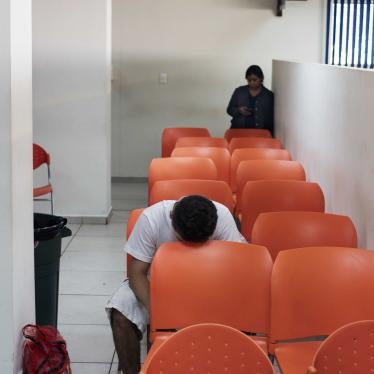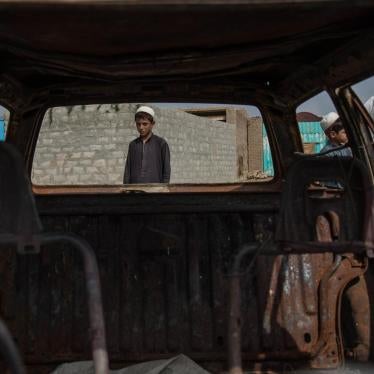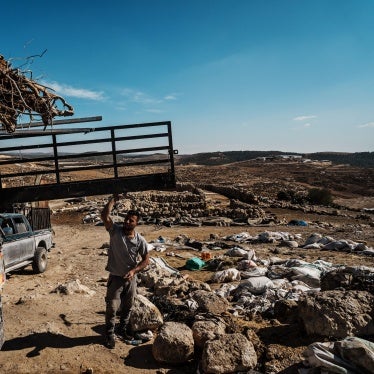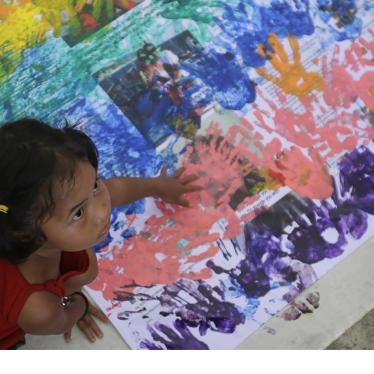(Washington, DC) – The US Senate Intelligence Committee’s report summary on the Central Intelligence Agency (CIA) detention and interrogation program is a powerful denunciation of the agency’s extensive and systematic use of torture, Human Rights Watch said today. The 525-page partially redacted summary, released on December 9, 2014, is part of a 6,700-page classified report that the committee has still not indicated it plans to release.
The summary documents numerous misrepresentations the CIA made about the program’s effectiveness and demonstrates US officials’ knowledge that it was illegal. It underscores the need for the US government to promptly release the full report, bolster oversight of the CIA, and investigate and appropriately prosecute the senior officials responsible for the torture program, Human Rights Watch said.
“The Senate report should not be relegated to a shelf or hard drive but be the basis for criminal investigations on the use of torture by US officials,” said Kenneth Roth, executive director of Human Rights Watch. “The failure of the Obama administration to hold those responsible for torture to account risks leaving torture as a policy option when the next inevitable security threat strikes.”
Nature and Scope of the Abuses
The summary concludes that CIA abuses were far more brutal, systematic, and widespread than previously reported; that many of the CIA’s interrogation techniques went beyond even those authorized by the Justice Department; and that the CIA began using the techniques long before they had obtained authorization for them.
The summary describes many previously reported facts about the CIA torture program, including the agency’s use of painful stress positions, forced standing, extended sleep deprivation, extensive bright light and loud noise exposure, waterboarding, and throwing detainees against walls or closing them into coffins.
It also contains new details showing that CIA torture was even more brutal than previously thought. The agency used painful restraints, imposed punitive “anal feeding” or “anal rehydration,” and forced detainees with broken leg bones to stand shackled against walls. The tactics took a heavy toll on the detainees, especially when combined with sleep deprivation and isolation and used over long periods. One detainee is described as “clearly a broken man,” another “on the verge of a complete breakdown.”
The summary also provides evidence corroborating many details contained in prior Human Rights Watch reporting about CIA abuses. As just one example, Human Rights Watch reported in 2012 on the CIA’s use of waterboarding and similar water torture against detainees, directly contradicting the CIA’s claim that it had waterboarded only three detainees. As noted in footnote 623 of the summary, Human Rights Watch reported in 2012 that detainee Mohammed Shoroeiya (who also went by the names Abd al-Karim or al-Shara'iya) provided detailed and credible testimony that he was waterboarded repeatedly during interrogations at a CIA detention site in Afghanistan. The summary corroborates that Shoroeiya was rendered into CIA hands in 2003 and notes that CIA documents include a photograph of a wooden waterboarding device surrounded by water buckets at the detention site where Shoroeiya was held. The summary also notes that in an interview, the CIA was unable to explain the presence of the waterboarding device at that site.
Human Rights Watch also reported on the case of Khalid al-Sharif (who also went by the name of “Abu Hazim”), who described being subjected to a form of water torture very similar to waterboarding while in CIA detention in Afghanistan. The summary describes, at pages 107-108, the testimony of a CIA linguist who in 2003 apparently reported this abuse to the CIA inspector general, who in turn referred it in 2004 to the US Attorney’s office for the Eastern District of Virginia as a possible criminal violation. It is unclear what, if anything, happened to the referral, but the inspector general’s report dismissed the linguist’s allegation by concluding there was no corroborating evidence. Sharif, like several other CIA detainees, has pointed out that no US official ever sought to interview him about the abuse he endured while in CIA custody.
CIA Knew the Techniques Were Illegal
The report reveals new evidence that the CIA was well aware of the illegality of the techniques it was employing. On page 33, the summary notes that senior lawyers at the CIA internally circulated a draft letter to Attorney General John Ashcroft dated July 8, 2002, expressly acknowledging that the interrogation tactics that came to be known as “enhanced interrogation techniques” violated the US Torture Statute. The draft – it is unclear if it was ever sent – requested that the Justice Department provide the CIA with “a formal declination of prosecution, in advance.” That is, the CIA sought a promise from the Justice Department never to prosecute –or immunity.
This document contradicts previous CIA officials’ claims that they did not know whether the tactics were legal and that they relied on guidance from Justice Department legal counsel in good faith. Instead, the document makes clear that senior CIA officials knew their tactics were illegal, and were trying to create some form of legal cover for those actions. When their efforts to obtain an advance declination failed, they sought and procured another form of cover through a series of legal memos – the so-called “Torture Memos” – drafted by the Justice Department’s Office of Legal Counsel and the White House counsel beginning in August 2002, which purported to authorize the techniques.
Various current and former CIA officials have tried to justify the use of abusive practices against detainees by relying on these memos. The new evidence that the CIA knew about the illegality of the techniques undercuts any claim by senior CIA officials that they were simply relying in good faith on legal guidance, Human Rights Watch said.
Moreover, the memos were not an honest assessment of the law proscribing torture as well as cruel, inhuman, or degrading treatment but a twisted effort to justify the unjustifiable. It has been a major failing of justice that the lawyers who provided legal cover for this torture program, becoming accomplices in its illegality, have not faced disciplinary or criminal consequences, Human Rights Watch said.
“It’s now clear that senior CIA officials knew from the beginning that the techniques they were using were illegal,” Roth said. “It is the height of cynicism for the CIA to continue appealing to the ‘Torture Memos’ as if it relied in good faith on their legal rationalizations.”
CIA Obstruction of Oversight
The summary shows the lengths to which the CIA went to cover up its crimes and obstruct the democratic process, including by making false claims to the Justice Department, White House, and Congress about the scope, nature, successes, and necessity of the program. At the same time, the summary shows senior White House officials knew from the start that the program was illegal, and that the administration kept even members of its own senior National Security Council and Defense Department team in the dark about the program.
At the direction of the White House, the summary states, the secretaries of state and defense, both principals on the National Security Council, were not briefed on program specifics until September 2003. The report describes a CIA email from 2003 stating that “[Secretary of State Colin] Powell would blow his stack if he were to be briefed on what’s been going on.”
The Senate Intelligence Committee initiated the study in 2009 after reports that the CIA had destroyed 92 videotapes of CIA interrogations of terrorism suspects. Despite the committee’s oversight role, no committee members, other than the then-chairman and vice-chairman, were briefed about the program, which began in 2002, until September 2006, hours before President George W. Bush disclosed the program to the public.
CIA efforts to evade oversight apparently did not end there. In March 2014, Senate Intelligence Committee Chair Dianne Feinstein reported that the CIA had spied on committee staff computers as they were conducting their oversight investigation. The CIA inspector general referred the matter to the Justice Department for prosecution, but the Justice Department declined. CIA Director John Brennan, who had repeatedly dismissed allegations of CIA wrongdoing, apologized on July 31 after an internal CIA investigation found that the agency had monitored committee staff computers.
“The CIA has tried to cover up its torture program by systematically obstructing oversight and sending false messages to the public,” Roth said. “Congress and the president should seize this opportunity to bolster oversight of the CIA and bring it under the rule of law.”
The Need for Accountability
On his second full day in office in January 2009, President Barack Obama signed an executive order closing the CIA’s secret detention facilities and ending the use of “enhanced interrogation techniques” – a euphemism for torture and other cruel or inhuman treatment. Although torture and other ill-treatment of people in custody violates US and international law, not a single US official responsible for creating or carrying out the program has been brought to justice.
“It’s unconscionable that President Obama refuses to allow prosecution of a single person who authorized, implemented, or covered up the torture,” Roth said.
Although the names of countries that cooperated with the US program were redacted in the summary, substantial evidence exists that the CIA sent prisoners to at least eight countries, including Afghanistan, Poland, Romania, Lithuania, Thailand, Morocco, Jordan, and Egypt.
The United States has often pressed other governments to prosecute serious human rights violations committed by their own officials. Besides sending a signal that the US will not tolerate detainee abuse at home, credible and fair prosecutions of US torture are crucial to US credibility on accountability abroad.
In 2009, the Justice Department initiated an investigation, led by Special Prosecutor John Durham, which it portrayed as a serious criminal inquiry into abuses against detainees in CIA custody. However, the investigation looked into only abuses that went beyond the interrogation techniques that the Justice Department had authorized, even though President Obama has acknowledged that some of the authorized techniques constituted torture.
Durham looked into 101 cases of CIA abuse, including the cases of two detainees who died in CIA custody. However, the Justice Department closed the investigation on August 2012 without bringing any criminal charges. In addition, it appears that the US never interviewed for the investigation many former CIA detainees who reportedly suffered some of the worst abuses in CIA custody. The US government has refused to answer questions as to whether any former CIA detainees were interviewed at all for the Durham investigation. The failure to conduct such interviews raises serious questions about US compliance with its obligations to conduct a full and fair inquiry under the Convention against Torture into potential violations, Human Rights Watch said.
“The Senate report summary should be the beginning, not the end, of the process to bring to justice those who committed torture in the name of the American people,” Roth said. “Real presidential leadership will be needed to ensure the next steps are taken.”






